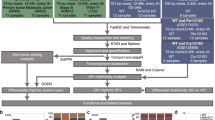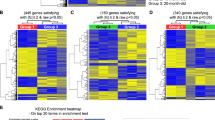Abstract
The relationship between the expression of Steroidogenic factor 1 (Sf1) and the circadian-related gene, period homolog 2 (Per2), in the adrenal cortex is still unknown. We show here that in Y1 adrenocortical tumor cells, expression of steroidogenic-related genes such as P450scc mRNA and Sf1 mRNA were asynchronous with Per2 mRNA. SF1 promoter analyses showed that the E-box element functions in a rhythmic pattern. Rhythmic expression of Upstream factor 1 mRNA, correlated well with Sf1 mRNA expression. We propose that tumorigenesis of adrenocortical lesions cause disruption of synchronous expression of steroidogenic-related and circadian-related genes.
Similar content being viewed by others
Article PDF
Author information
Authors and Affiliations
Rights and permissions
About this article
Cite this article
Ohe, K., Sonoda, K., Akashi, M. et al. Asynchronous Rhythm of Steroidogenic Factor 1 and Period Homolog 2 mRNA Expression in Mouse Y1 Adrenocorticol Tumor Cells. Nat Prec (2010). https://doi.org/10.1038/npre.2010.4523.1
Received:
Accepted:
Published:
DOI: https://doi.org/10.1038/npre.2010.4523.1



